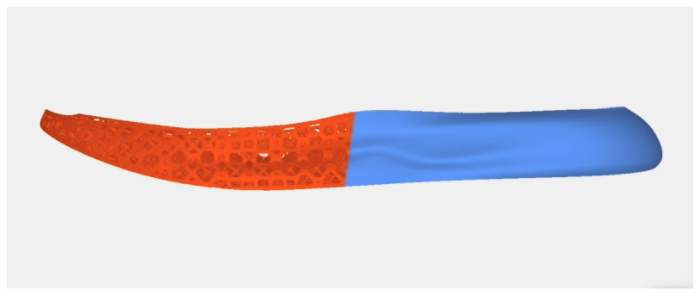Manufacturers continuously look for ways to increase efficiency and productivity while reducing waste and cost. They also look to incorporate new technologies into their facilities to solve productivity challenges, increase agility, support customization workflows, and increase production automation. Some of the latest advances in 3D printing technologies are making it easier for manufacturers to incorporate additive manufacturing in their manufacturing workflows and scale it for volume production.
Recent innovations in additive manufacturing technology increase productivity and the agility of traditional manufacturing models. Additive manufacturing techniques can replace traditional operations or complement existing production processes for a range of products. Manufacturers should consider the advantages and disadvantages of moving to an all-additive manufacturing model because a hybrid approach offers numerous benefits. This article will weigh the pros and cons to clarify that choice.

Should Your Company Incorporate Additive Manufacturing Techniques?
Companies that want to boost their manufacturing operations productivity might consider adding additive production capacity to their facilities. Additive manufacturing provides several advantages and broadens the scope of possible products produced in-house or through an external services provider.
Advantages of Additive Manufacturing Techniques
A significant advantage of additive manufacturing is its production versatility and agility but eliminating the need for tooling. A single 3D printing system and a qualified set of advanced materials can produce multiple products with a single process. 3D printers are able to produce complex parts with little impact on the production process. Therefore, highly complex parts often require the same amount of time and cost to produce as a simple part with the same material and weight.

This primary advantage of 3D printing in additive manufacturing operations offers several other benefits:
- On-demand production and scaling: Production with 3D printing can begin on-demand with no MOQ. Parts can also be produced with high mix and in large batches using a single process. In addition, production can scale up or down as needed, which eliminates the need to hold inventory.
- Increased agility and versatility: Due to the elimination of tooling in 3D printing processes, it’s a simple matter to move production capacity to a new location or add additional printers should market demand change.
- Localize manufacturing: 3D printing systems enable more mobile and localized manufacturing operations. It’s convenient to set up a smart factory near the customer base and/or the current production facility.
- Design freedom and complexity: 3D printing supports highly complex parts with no increase in cost over simple parts. Parts that are otherwise impossible to manufacture or require numerous parts and assembly can be streamlined through 3D printing.
- Reduction of parts: Because 3D printing is not constrained by traditional manufacturing techniques like injection molding, items that once required assembly of multiple pieces have the option of being consolidated, often requiring only one part to produce the finished product.
Today’s 3D printing systems come with larger build areas and higher precision than earlier prototyping systems. Manufacturers now produce complex batches of products on industrial scales with high precision (30-50 microns) using specialized 3D printing materials. Although CAPEX can be comparable to a traditional operation, ongoing costs are competitive and easier to maintain. Only a single system is needed for production, and labor costs are highly competitive due to eliminating highly skilled laborers in a mostly automated process. Overall, implementing additive manufacturing techniques in a traditional manufacturing operation keeps companies agile and allows them to respond to market demand quicker than the competition.
Disadvantages of Additive Manufacturing Techniques
Despite several advantages, some drawbacks exist when implementing additive manufacturing techniques:
- Limited materials: Not all traditional materials are compatible with 3D printers, although the range of available additive manufacturing materials continues to expand. 3D printing is harder to adopt if very specialized materials or certifications are needed, notably metals.
- Restrictive build size: The throughput of an additive manufacturing process is equivalent to the size of the build volume in a 3D printer. Therefore, 3D printing is currently a better option for smaller products with highly complex structures. Larger products that require complex details are ideal for CNC machining augmented by additive techniques.
- Post-processing: 3D printed products require some post-processing, potentially including support removal, washing and curing, or annealing. The required post-processing steps depend on the printing process and materials. Advancements in additive manufacturing like LuxCreo’s Digital Polishing™ are not producing transparent, clear parts without significant post processing.
- Disposal of chemicals: 3D printing uses materials and sometimes chemicals that require specialized disposal. However, 3D printing processes produce very low waste compared to subtractive manufacturing and injection molding and regeneration systems for wash detergents support more sustainable and circular additive manufacturing.
A Comprehensive Additive Manufacturing Process
As mentioned, 3D printing eliminates the need for tooling, so companies do not need to use separate processes for product development, prototyping, and full-scale production. 3D printing can augment any production stage, including aesthetic prototyping, functional prototyping, and preparing to scale. Companies that want to start implementing additive manufacturing techniques in their operations need to work with a partner that provides hardware, software, materials, and smart factory technology to ensure simple scaling.
LuxCreo provides the next generation of additive manufacturing solutions with Smart Factory 3D printers. Smart Factory 3D printers simplify manufacturing and produce higher-performance products for many industries at scale. Companies can bring additive production capacity in-house with LuxCreo’s Smart Factory 3D Printers or outsource production to LuxCreo’s Smart Factories that provide on-demand engineering and production services. For more information on how our solutions and services can improve your supply chain and manufacturing processes, visit our contact page or call (650) 336-0888.
